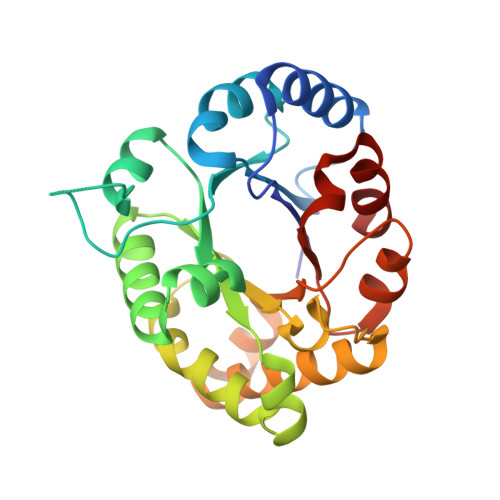Probing the role of highly conserved residues in triosephosphate isomerase - analysis of site specific mutants at positions 64 and 75 in the Plasmodial enzyme
Bandyopadhyay, D., Murthy, M.R., Balaram, H., Balaram, P.(2015) FEBS J 282: 3863-3882
- PubMed: 26206206
- DOI: https://doi.org/10.1111/febs.13384
- Primary Citation of Related Structures:
4ZZ9, 5BMW, 5BMX, 5BNK, 5BRB - PubMed Abstract:
Highly conserved residues in enzymes are often found to be clustered close to active sites, suggesting that functional constraints dictate the nature of amino acid residues accommodated at these sites. Using the Plasmodium falciparum triosephosphate isomerase (PfTIM) enzyme (EC 5.3.1.1) as a template, we have examined the effects of mutations at positions 64 and 75, which are not directly involved in the proton transfer cycle. Thr (T) occurring at position 75 is completely conserved, whereas only Gln (Q) and Glu (E) are accommodated at position 64. Biophysical and kinetic data are reported for four T75 (T75S/V/C/N) and two Q64 (Q64N/E) mutants. The dimeric structure is weakened in the Q64E and Q64N mutants, whereas dimer integrity is unimpaired in all four T75 mutants. Measurement of the concentration dependence of enzyme activity permits an estimate of Kd values for dimer dissociation (Q64N = 73.7 ± 9.2 nm and Q64E = 44.6 ± 8.4 nm). The T75S/V/C mutants have activities comparable to the wild-type enzyme, whereas a fourfold drop is observed for T75N. All four T75 mutants show a dramatic fall in activity between 35 °C and 45 °C. Crystal structure determination of the T75S/V/N mutants provides insights into the variations in local interactions, with the T75N mutant showing the largest changes. Hydrogen-bond interactions determine dimer stability restricting the choice of residues at position 64 to Gln (Q) and Glu (E). At position 75, the overwhelming preference for Thr (T) may be dictated by the imperative of maintaining temperature stability of enzyme activity.
Organizational Affiliation:
Molecular Biophysics Unit, Indian Institute of Science, Bangalore, India.
















